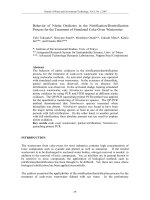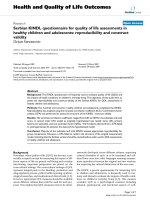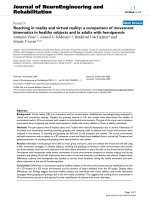Behavior of Pipe Piles in Sand : Plugging and Pore-Water Pressure Generation During Installation and Loading pptx
Bạn đang xem bản rút gọn của tài liệu. Xem và tải ngay bản đầy đủ của tài liệu tại đây (4.38 MB, 284 trang )
Springer Series in Geomechanics and
Geoengineering
Editors: Wei Wu · Ronaldo I. Borja
2
Using 360-degree Feedback in Organizations
This page intentionally left blank
Magued Iskander
Behavior of Pipe Piles
in Sand
Plugging and Pore-Water Pressure
Generation During Installation and Loading
ABC
Professor Wei Wu, Institut für Geotechnik, Universität für Bodenkultur, Feistmantelstraße
4, 1180 Vienna, Austria, E-mail:
Professor Ronaldo I. Borja, Department of Civil and Environmental Engineering, Stanford
University, Stanford, CA 94305-4020, USA, E-mail:
Author
Magued Iskander, PhD, PE, F.ASCE
Civil Engineering Department
Polytechnic Institute of New York University
Six Metrotech Center
Brooklyn, NY 11201
USA
E-mail:
ISBN 978-3-642-13107-3 e-ISBN 978-3-642-13108-0
DOI 10.1007/978-3-642-13108-0
Springer Series in Geomechanics and Geoengineering ISSN 1866-8755
c
2010 Springer-Verlag Berlin Heidelberg
This work is subject to copyright. All rights are reserved, whether the whole or part of the material is
concerned, specifically the rights of translation, reprinting, reuse of illustrations, recitation, broadcasting,
reproduction on microfilm or in any other way, and storage in data banks. Duplication of this publication
or parts thereof is permitted only under the provisions of the German Copyright Law of September 9,
1965, in its current version, and permission for use must always be obtained from Springer. Violations
are liable for prosecution under the German Copyright Law.
The use of general descriptive names, registered names, trademarks, etc. in this publication does not
imply, even in the absence of a specific statement, that such names are exempt from the relevant protective
laws and regulations and therefore free for general use.
Type Design and Cover Design: Scientific Publishing Services Pvt. Ltd., Chennai, India.
Printed on acid-free paper
543210
springer.com
To
Sherry,
Lolli, Kito,
& My Parents
2
Using 360-degree Feedback in Organizations
This page intentionally left blank
Contents
1 Introduction 1
1.1 Background 1
1.2 Installation Effects That Influence the Capacity of Pipe Piles in Sand 2
1.2.1 Plugging of Piles 2
1.2.2 Buildup of Pore Water Pressure 3
1.3 Scope and Objectives 4
1.4 Organization of This Book 4
References 5
2 Review of Design Guidelines for Piles in Sand………………………………7
2.1 Introduction 7
2.2 API Design Guidelines for Piles in Sand 8
2.3 The Database 10
2.4 Analysis Using the 2000 API RP 2A 14
2.5 Assessment of the API Method for Piles in Sand 16
2.6 Sources of Inaccuracy in the API Method 17
2.6.1 Statistical Considerations 17
2.6.2 Installation Effects 17
2.6.3 Axial Capacity Mechanism 18
2.6.3.1 Pile Movements 18
2.6.3.2 State of Stress in the Vicinity of the Pile 18
2.6.3.3 Friction Between Pile and Soil 19
2.6.3.4 Tension versus Compression 20
2.6.3.5 Type and Rate of Loading 20
2.6.4 Piles Driven through Clays into Sand 20
2.7 Conclusions 21
References 21
3 Installation Effects on the Capacity of Piles in Sand……… …………….25
3.1 Introduction 25
3.2 Plugging of Piles 25
3.2.1 Plugging of Piles during Installation 26
3.2.2 Plugging of Piles during Static Loading 26
3.2.3 Plugging of Piles during Cyclic Loading 27
3.3 Buildup of Pore Pressures during Driving 28
3.3.1 Excess Pore Pressures in Clays 28
VIII Contents
3.3.2 Excess Pore Pressures in Sands 28
3.3.3 Effects of Pile Setup on Drivability 29
3.4 Stress Redistribution Due to Driving 29
3.5 Conclusions 30
References 31
4 Experimental Facilities to Study the Behavior of Piles 35
4.1 Introduction 35
4.2 General Layout 36
4.3 The Pressure Chamber 36
4.3.1 Design of the Pressure Chamber 40
4.3.2 Preparation of Soil Specimens 44
4.3.2.1 Sand Placement by Dry Pluviation 44
4.3.2.2 Saturation of the Soil Specimen 51
4.3.2.3 Sand Drying 55
4.3.3 Chamber Effects 58
4.3.3.1 Size Effects 58
4.3.3.2 Boundary Conditions 59
4.3.3.3 Aging Effects 59
4.3.3.4 Wave Reflection Effects 60
4.4 The Loading System 60
4.4.1 The Loading Frame 60
4.4.2 The Feedback Control System (Closed Loop) 62
4.4.2.1 The Hydraulic Power Source (Hydraulic Pump) 63
4.4.2.2 The Hydraulic Actuator (Hydraulic Ram) 63
4.4.2.3 The Servovalve 63
4.4.2.4 The Load Cell 64
4.4.2.5 The Control Unit 64
4.5 The Data Acquisition System 65
4.5.1 The Computer 65
4.5.2 Data Acquisition Hardware 65
4.5.3 Data Acquisition Software 68
4.5.4 Signal Conditioning Equipment 68
4.5.5 Sensors 70
4.5.5.1 Load 70
4.5.5.2 Displacement 70
4.5.5.3 Plug Movement 71
4.5.5.4 Strains & Pore Pressures 71
4.6 Conclusions 73
References 73
5 Instrumented Double–Wall Pipe Pile to Study Behavior of Piles 75
5.1 Introduction 75
5.2 The Double-Wall Concept 76
5.3 Design of the Double-Wall Pile 79
5.3.1 Conceptual Design 79
Contents IX
5.3.2 Geometric Design 82
5.3.3 Mechanical Design 87
5.3.3.1 Axial Buckling 88
5.3.3.2 In-plane Buckling Failure Mode 91
5.4 Instrumentation 92
5.4.1 Instrumentation Layout 92
5.4.2 Instrumentation for Strain Measurements 93
5.4.2.1 Selection of Strain Gages 93
5.4.2.2 Installation of Strain Gages 96
5.4.3 Instrumentation for Pore-Pressure Measurements 103
5.4.3.1 Selection of the Pore Pressure Transducers 103
5.4.3.2 Design of Pore Pressure Transducers 104
5.4.3.3 Operation of the Pore-Pressure Transducers 107
5.4.4 Instrumentation Circuits 107
5.4.4.1 Strain Gage Circuits 110
5.4.4.2 Pore-Pressure Transducer Circuits 113
5.5 Protection from Driving Stresses 113
5.5.1 Solid State Encapsulation 114
5.5.1.1 Encapsulation of the Annular Space 114
5.5.1.2 Encapsulation of the Electrical Connections 115
5.5.2 Bonding Instrumentation Wires to the Pile Walls 116
5.5.3 Stress Reduction in Electrical Connections 116
5.6 Load Transfer between the Two Walls of the Pile 117
5.7 Calibration of the Double-Wall Pile 120
5.7.1 Strain Gages 120
5.7.2 Pore Pressure Transducers 123
5.8 Conclusions 123
References………………………………………………………………124
6 Electro Pneumatic Laboratory Pile Hammer………………………… 127
6.1 Introduction 127
6.2 Background 127
6.3 Special Considerations in the Design of Laboratory Pile Hammers 129
6.3.1 Type of Hammer 129
6.3.2 Hammer Geometry 130
6.3.2.1 Hammer Shape 131
6.3.2.2 Length to Diameter Ratio 132
6.3.2.3 Ram Weight 132
6.3.2.4 Location of the Control Unit 133
6.4 Layout of the Driving System 133
6.4.1 The Hammer 133
6.4.2 The Leaders (Guide System) 138
6.4.3 The Control Unit 138
6.5 Mechanical Design of the Hammer 139
6.5.1 Wave Equation Analysis 139
6.5.2 Analysis of the Hammer’s Force-Time Signal 148
6.6 Design of the Electro-Pneumatic Control System 150
X Contents
6.6.1 Basic Principles of Gaseous Fluid Flow 150
6.6.1.1 Capacity Coefficient 151
6.6.1.2 Standard Volume 152
6.6.2 Selection of the Pneumatic Components 152
6.6.2.1 Required Capacity Coefficient 152
6.6.2.2 Required Air Consumption 153
6.6.3 The Electro-Pneumatic Circuit 154
6.7 Performance of the Hammer 158
6.7.1 Raw Performance of the Hammer 158
6.7.1.1 Efficiency 159
6.7.1.2 Performance of the Electro-Pneumatic Control
System 163
6.7.1.3 Repeatability 163
6.7.1.4 Ram Acceleration 164
6.8.2 Hammer Performance during Pile Driving 165
6.8.2.1 Force-Time Curve 165
6.8.2.2 Energy Delivered to the Pile 167
6.8.2.3 Ram Dwell Time 169
6.8.2.4 Pile Set 173
6.8.2.5 Wave Equation Analysis 173
6.9 Conclusions 173
References 174
7 Geotechnical Properties of the Testing Sand…………………………… 177
7.1 Introduction 177
7.2 Preliminary Choices 177
7.3 Selection of the Test Sand 178
7.4 Geotechnical Properties of Oklahoma Sand 179
7.4.1 Physical Properties 179
7.4.2 Shear Strength 181
7.4.2.1 Triaxial Tests 181
7.4.2.2 Direct Shear Tests 181
7.4.3 Hydraulic Conductivity 181
7.4.4 Changes in Sand Properties Due to Recycling 186
References 186
8 Similitude between Model and Full Scale Piles………………………… 187
8.1 Introduction 187
8.2 Similitude 187
8.3 Scaling Laws 188
8.4 Modeling Capabilities of the Experimental Facilities 188
8.4.1 Modeling of Earth Stresses in the Pressure Chamber 191
8.4.2 Modeling of Pile Driving Using the Hammer 192
8.4.2.1 Modeling of Dynamic Phenomena 192
8.4.2.2 Modeling of Diffusive Phenomena 193
8.5 Conclusions 194
References 194
Contents XI
9 Load Tests Using the Double–Wall Pipe Pile in Sand……………………195
9.1 Introduction 195
9.2 Test Procedure 195
9.3 Data Presentation 196
9.3.1 Stresses and Pore Pressures 196
9.3.2 Plug Measurements 197
9.4 Load Tests on the Pile Pushed (Jacked) in Dry Sand 198
9.4.1 Jacking (Pushing) Stage 198
9.4.2 Load Test 209
9.4.3 Pull-Out Test 210
9.5 Load Tests on the Pile Pushed (Jacked) in Saturated Sand 210
9.5.1 Jacking (Pushing) Stage 223
9.5.2 Load Test 223
9.5.3 Pull-Out Test 224
9.6 Load Tests on the Pile Driven in Saturated Sand 225
9.6.1 Driving Stage 225
9.6.2 Load Test 240
9.6.3 Pull-Out Test 241
9.7 Observed Behavior of Piles in Sand 241
9.7.1 Pile Plugging 241
9.7.2 Buildup of Pore Pressures 242
9.7.3 Load Transfer 242
9.8 Conclusions 242
References 243
10 Summary and Conclusions……………………………………………….245
10.1 Background 245
10.2 Summary 246
10.3 Conclusions 247
10.3.1 Conclusions Regarding Experimental Apparatus 247
10.3.1.1 The Double-Wall Pile 247
10.3.1.2 The Pile Hammer 247
10.3.1.3 The Pressure Chamber System 247
10.3.1.4 Modeling Capabilities of the Developed
Apparatus 248
10.3.2 Conclusions Regarding the Behavior of Piles in Sand 248
10.3.2.1 Pile Plugging 248
10.3.2.2 Buildup of Pore Pressures during Installation
and Loading 248
10.3.2.3 Load Transfer 249
10.4 Recommendations for Future Research 249
References 249
References 251
Index 263
2
Using 360-degree Feedback in Organizations
This page intentionally left blank
Acknowledgements
Most of the ideas presented in this manuscript originated at a time when I worked
with Professor Roy Olson at The University of Texas at Austin. I am grateful to
Professor Olson for his advice, friendship, and his careful review of an earlier ver-
sion of this manuscript. It has been both a privilege and a pleasure to have worked
with him.
A large number of professional colleagues contributed formally and informally
to the success of this effort. Professors James Bay, Utah State University; J. Don
Murff, Texas A&M University; Ken Stokoe, The University of Texas at Austin;
Priscilla Nelson, New Jersey Institute of Technology; Jean-Louis Briaud, Texas
A&M University; Jack Templeton, Sage Engineering; and the Late Professors
Lymon Reese, The University of Texas and Michael O’Neill, The University of
Houston provided valuable advice and crucial insights. Aaron Goldberg, PE; San-
jeev Malhotra, PE; Casey Jones, PE; James Doran; Robert Pavlicheck, PE; and
Dr. Omar Alansari assisted in equipment design, manufacturing, and testing.
My graduate students Saumil Parikh, and Bhujang Patel proofread the entire
manuscript.
Portions of this research were funded by NSF’s Offshore Technology Research
Center (Grant No. CDR 8721512). Continued NSF funding under grants No.
CMMI 9733064, DGE 0337668, and DGE 0741714 is gratefully acknowledged.
I am grateful to Dr. Thomas Ditzinger for adopting this manuscript into the
Springer Series on Geomechanichs and Geoengineering. I am also thankful to the
series editors: Prof. Wei Wu from Universität für Bodenkultur in Austria and Prof.
Ronaldo Borja from Stanford University for recommending publication of this
manuscript. Credit is also due to Mrs. Heather King from Springer for her assis-
tance during the production of this work.
Last but not least, I would like to express my gratitude to my family, particu-
larly my parents and my wife. This work could not have been finished without
their support, encouragement, and love.
2
Using 360-degree Feedback in Organizations
This page intentionally left blank
Selected Unit Conversions
Conversions from American (English) to SI Units
Length 1 in. = 2.54 cm
1 ft = 0.3048 m
Area 1 in.
2
= 6.452 cm
2
1ft
2
= 929.03 cm
2
Volume 1 in.
3
= 16.387 cm
3
1 ft
3
= 28.317 x10
-3
m
3
Force 1 lb = 4.448 N
1 kip = 4.448 kN
1 US Ton = 8.896 kN
Stress 1 psi = 6.895 kN/m
2
1 psf = 47.88 N/m
2
1 tsf = 95.76 kN/m
2
1 kip/ft
2
= 47.88 kN/m
2
Unit Weight 1 pcf = 0.1572 kN/m
3
Moment 1 lb-ft = 1.3558 N.m
1 lb-in. = 0.11298 N.m
Energy 1 ft-lb = 1.3558 J
Conversions from SI Units to American (English) Units
Length 1 m = 3.281 ft
1 cm = 0.3937 in
Area 1 m
2
= 10.764 ft
2
1 cm
2
= 0.155 in.
2
Volume 1 m
3
= 35.32 ft
3
1 cm
3
= 0.061023 in.
3
XVI Selected Unit Conversions
Force 1 N = 0.2248 lb
1 kN = 0.2248 kip
1 metric ton = 2204.6 lb
Stress 1 kN/m
2
= 20.885 psf
1 kN/m
2
= 0.01044 tsf
1 kN/m
2
= 0.145 psi
Unit Weight 1 kN/m
3
= 6.361 pcf
Moment 1 N.m = 0.7375 lb-ft
1 N.m = 8.851 lb-in.
Energy 1 J = 0.7375 ft-lb
M. Iskander: Behavior of Pipe Piles in Sand, SSGG, pp. 1–6.
springerlink.com © Springer-Verlag Berlin Heidelberg 2010
1. Introduction
Abstract. Design guidelines for predicting the axial capacity of piles in sand have
long been the source of considerable debate due to the geotechnical profession’s
inadequate understanding of pile behavior. Analytical studies, alone, cannot re-
solve the uncertainties in axial capacity predictions due to the complex nature of
pile behavior in sand. This chapter presents some of the factors which occur dur-
ing installation and loading of pipe piles in sand, along with their potential impact
on axial capacity.
1.1 Background
There are many challenges facing the designers of pile foundations in sand, par-
ticularly in offshore environments. Most offshore structures are supported on steel
pipe piles which are designed in accord with API Recommended Practice for
Planning, Designing, and Constructing Fixed Offshore Platforms, RP-2A (API,
2000). The recommended practice has long been the accepted standard for pile
design as evidenced by its wide spread use (Lacasse 1988, Pelletier et al. 1993).
The document, RP-2A, is currently in its twenty first edition, however, little has
changed in the recommended practice for piles in sand since the fifteenth edition
was published in 1984. The publication of the fifteenth edition, with significant
changes in the criteria for predicting the shaft capacity of piles in sand was con-
troversial and, instigated a round of criticism and debate (e.g. Lings, 1985;
Randolph, 1985; and Toolan et al. 1990).
The accuracy of the API approach has been evaluated by comparing the pre-
dicted pile capacities to the measured pile capacities of known case histories (Ol-
son and Iskander 1994, Iskander and Olson 1992). The scatter between measured
and predicted pile capacities is significantly larger for piles in sand than piles in
clay (Olson and Dennis, 1982). The primary inadequacy of the
API method is the
database used to calibrate the design method. At the present time, the database
has fewer load tests than the number of degrees of freedom of the pile-soil system,
which precludes determining a unique set of calibration factors (Olson and Is-
kander 2009). Furthermore, the database consists of piles that are generally
shorter in length, smaller in diameter, and have less capacity than the piles being
designed for offshore structures.
Variations between measured and predicted pile capacities arise due to a num-
ber of factors such as severe changes in soil properties and state of stress caused
by pile driving, difficulties in measuring field soil properties particularly in the
marine environment, variations in loading details and pile installation procedures,
2 1. Introduction
uncertainties in the behavior of the soil core (plug) during driving and subsequent
loading, and soil structure interaction. Most design methods, including the
API
method, account for these factors by calibrating a simple theoretical model using
empirical factors.
Although these factors are most pronounced in offshore piling, they are equally
relevant to traditional terrestrial geotechnical engineering. In the terrestrial envi-
ronment, many uncertainties in pile capacity predictions can be avoided by driving
piles to “refusal” in deep layers of hard clay, dense sand, or rock. When strong
layers are not available, and driving piles to refusal is not possible, engineers often
apply conservative assumptions and rely on proof tests to verify the design capac-
ity. So a better understanding of the effects of installation on the capacity of piles
has the potential to provide cost savings for both terrestrial and offshore piles.
1.2 Installation Effects That Influence the Capacity of Pipe
Piles in Sand
1.2.1 Plugging of Piles
During installation of open-ended pipe piles, the soil enters the pile at a rate that is
equal to, or larger than, the rate of pile penetration. This mode of penetration is
referred to as coring or cookie cutter. As penetration progresses, the soil core in-
side the pile may develop sufficient frictional resistance along the inner pile wall
to prevent further soil intrusion, causing the pile to become plugged. Plugging is
important, not only because it directly contributes to the tip bearing capacity, but
also because it indirectly contributes to the developed shaft capacity (Gavin and
Lehane 2002, Paik and Salgado 2003), since a plugged pile displaces more soil
than a coring one, which increases the effective stresses surrounding the pile.
Plugging also influences the dynamic behavior of piles, which complicates the dy-
namic analyses of piles (Paikowsky and Whitman, 1990; Raines et al. 1992).
The common view is that most piles that plug during static loading do not plug
during driving (Paik and Lee 1993, Hight et al. 1996, Hajduk et al. 2009). Smith
and Chow (1982) attributed this phenomenon to a combination of inertial effects
and an increase in the dynamic bearing capacity factor, Nq, over its static value.
Additionally, Smith et al. (1986) argued that the driven pile mobilizes all of its in-
ternal and external friction intermittently during penetration and, as a result, the
soil core advances up the pile. Conversely, Paikowsky et al. (1989) argued that
“the pile plugging phenomenon is of frequent occurrence and is of greater signifi-
cance than that presently accorded it by the profession.” The degree of plugging
depends on soil properties (Lehane and Gavin 2001), the hammer characteristics,
and the pile’s frictional resistance (Brucy et al. 1991).
1.2 Installation Effects That Influence the Capacity of Pipe Piles in Sand 3
On some occasions, piles may plug and impede driving. If the available pile
hammer cannot drive the pile to the design depth a problem may arise, particularly
for piles with thickened walls near the surface or mud-line, such as piles used to
resist lateral loading (Murff et al., 1990). If the pile “refuses” prematurely, the re-
quired thick section may end up above the mud-line. In these circumstances, the
plug is typically removed by drilling or jetting. The effects of the removal of the
soil plug on the final pile capacity are controversial. Brucy et al. (1991) claimed
that static loading results are not changed by partial removal of the soil plug.
Other studies indicate that jetting results in a substantial reduction in the over-all
pile capacity, even if the pile is re-driven (McClelland and Focht, 1955).
Arching of soil within a few pile diameters from the tip is sufficient to form a
plug (Leong and Randolph 1991). Furthermore, the available soil friction along
the inside of pipe piles is significantly higher than the common design values for
the external skin friction, for sands (Paik et al. 2003, Murff et al. 1990), clays
(Randolph, 1987), and even for calcareous soils (Randolph et al. 1990). Small de-
formations on the order of 2 mm are required to mobilize arching that is necessary
for plugging, particularly in dense sands (Kishida et al. 1985). Nevertheless, piles
that plug during static loading may exhibit smaller tip bearing capacities than their
closed-end counterparts at the same pile head settlement (Szechy 1958, Briaud and
Audibert 1990). O’Neill and Raines (1991) concluded that the reduction in tip
bearing capacity is primarily due to the plug’s compressibility, while Lehane and
Randolph (2002) ascribe the effect to compressibility of the soil below the plug.
De Nicola and Randolph (1997) found that the plug length increased with in-
creasing relative density of insitu sands during driving and decreased with increas-
ing relative density during jacking. Also, during installation, the jacked piles
exhibited a greater tendency to plug than the driven piles. This points to the im-
portance of testing driven model piles.
1.2.2 Buildup of Pore Water Pressure
Arching of soils inside the pile to form a plug depends on the ability of the soil to
drain pore pressures and develop high frictional stresses along the soil/pile inter-
face. Under cyclic or earthquake loading, the soil core may become partially
drained, which may prevent pile plugging (Randolph et al. 1991), or reduce pile
capacity (Choi and O’Neill 1997).
There has been increasing recognition of gain in pile capacities in sand with
time. York et al. (1994) attributed the gain over a period of a few weeks to dissi-
pation of pore water pressure. Chow et al. (1998) attributed the gain over a period
of 5 years to creep that leads to break down of circumferential arching stresses al-
lowing increase in radial stress as well as increased dilatation due to aging.
4 1. Introduction
1.3 Scope and Objectives
Analytical studies, alone, cannot resolve the uncertainties in axial capacity predic-
tions due to the complex nature of pile behavior. Experimental research on the
physical processes that control the behavior of piles during installation and load-
ing is required in order to resolve the issues involved. Considering the large num-
ber of variables involved in axial pile capacity development, as well as the high
cost of load tests on full scale instrumented piles, it is unlikely that a sufficient
number of full scale load tests can be performed to resolve the problem. Further-
more, the test conditions of full-scale load tests, generally, cannot be controlled
satisfactorily to isolate independent variables. Experimental research on model
piles can, however, be used to resolve some of the important design uncertainties.
The objectives of this monograph presents a detailed blue print for developing
experimental facilities necessary to investigate the effects of plugging and pore-
water pressure generation on the capacity of piles. These facilities include a
unique instrumented double-walled pipe pile that is used to delineate the frictional
stresses acting against the external and internal surfaces of the pile. The pile is fit-
ted with miniature pore-pressure transducers to monitor the generation of pore wa-
ter pressure during installation and loading. A fast automatic laboratory pile ham-
mer capable of representing the phenomena that occur during pile driving was also
developed and used. Finally, a pressure chamber; feedback control system; data
acquisition system; loading frame; sand handling, pluviating, saturating, and dry-
ing apparatus have been integrated to allow convenient load testing of piles under
simulated field conditions. The experimental apparatus is presented with sufficient
details to allow readers to duplicate or modify the design to suit their own needs.
A number of load tests were carried out to identify the effects of inertia and
build-up of pore water pressure on pile plugging. Continuous measurement of dy-
namic and static excess pore pressures, frictional and end bearing stresses, and the
elevation of the soil inside the pile during installation and loading are presented.
The results of the testing program validate the performance of the developed appa-
ratus, and provide unique insights into soil-structure interaction during pile driving
and subsequent loading. The work contributes to a better understanding of pile
behavior.
1.4 Organization of This Book
This monograph consists of four main parts. The subject is introduced along with
previous research in chapters one, two, and three. The design and performance of
the experimental facilities is presented in chapters four, five, and six. The proper-
ties of the test soil and scaling considerations are presented in chapters seven and
eight, respectively. A testing program to investigate the behavior of piles during
installation and subsequent loading is presented in chapter nine. A summary of the
work along with conclusions are presented at the end.
References 5
References
American Petroleum Institute (API): Recommended Practice for Planning, Designing, and
Constructing Fixed Offshore Platforms, Working Stress Design, 21st edn. (RP 2A-
WSD), American Petroleum Institute (2000)
Briaud, J., Audibert, J.: Some Thoughts on API RP2A for Vertically Loaded Piles. In: Proc.
22nd Offshore Technology Conf., pp. 9–16 (1990), doi:10.4043/6418-MS
Brucy, F., Meunier, J., Nauroy, J.F.: Behavior of Pile Plug in Sandy Soils During and After
Driving. In: Proc. Offshore Technology Conf., Paper No: 6514-MS (1991),
doi:10.4043/6514-MS
Choi, Y., O’Neil, M.: Soil Plugging and Relaxation in Pipe Pile During Earthquake Motion.
ASCE J. Geotechnical and Geoenvironmental Engr. 123(10), 975–982 (1997)
Chow, F., Jardine, R., Brucy, F., Nauroy, J.: Effect of Time on Capacity of Pipe Piles in
Dense Marine Sand. ASCE J. Geotechnical and Geoenvironmental Engr. 124(3),
254–264 (1998)
De Nicola, A., Randolph, M.: The Plugging Behaviour of Driven and Jacked Piles in Sand.
Geotechnique 47(4), 841–856 (1997)
Gavin, K., Lehane, B.: The shaft capacity of pipe piles in sand. Canadian Geotechnical
J. 40, 36–45 (2002)
Hajduk, E., Lin, G., Adams, J., Ledford, D.: Experiences with Open Ended Pipe Pile Plug-
ging in The Atlantic Coastal Plain. In: Iskander, M., et al. (eds.) Contemporary Topics in
Deep Foundations (GSP 158), pp. 1–10 (2009), doi:10.1061/40902(221)38
Hight, D., Lawrence, D., Farquhar, G., Mulligan, G., Gue, S., Potts, D.: Evidence for Scale
Effects in the End Bearing Capacity of Open-Ended Piles in Sand, Paper No. 7975-MS
(1996), doi:10.4043/7975-MS
Iskander, M.G., Olson, R.E.: Review of API Guidelines for Pipe Piles in Sand. In: Proc.,
Civil Engineering in the Oceans V, ASCE, pp. 798–812 (1992)
Kishida, H., Isemoto, N.: Behavior of Sand Plugs in Open Ended Steel Pipe Piles. In: Proc.
9th Int. Conf. on Soil Mechanics and Foundation Engineering, Tokyo, pp. 601–604
(1977)
Kishida, H., Uesugi, M., Susumu, M.: Behavior of Dry Sands in Steel Pipe Piles. In: Proc.
8th Southeast Asian Geotechnical Conf., Kuala Lumpur (1985)
Lacasse, S.: Uncertainties in Offshore Geotechnical Engineering, Int. Survey of API-RP 2A
Design Parameters for Axial Capacity of Driven Piles in Sand, Norwegian Geotechnical
Institute, Report No: 85307-14 (1998)
Lehane, B., Gavin, K.: Base Resistance of Jacked Pipe Piles in Sand. ASCE J. Geotechnical
and Geoenvironmental Engineering 127(6), 473–480 (2001)
Lehane, B., Randolph, M.: Evaluation of a Minimum Base Resistance for Driven Pipe Piles
in Siliceous Sand. ASCE J. Geotechnical and Geoenvironmental Engineering 128(3),
198–205 (2002)
Leong, E., Randolp, M.: h Finite Element Analysis of Soil Plug Response. Int. Journal of
Numerical and Analytical Methods in Geomechanics 15, 121–141 (1991)
Lings, M.L.: The Skin Friction of Driven Piles in Sand, M.Sc. Thesis, Imperial College of
Science and Technology, University of London (1985)
McClelland, B., Focht, J.: Padre Island Load Tests, Project Report, McClelland Engineers
(Fugro-McClelland Marine Geosciences), 6100 Hilcroft, Houston, Texas (1955)
Murff, J., Raines, R., Randolph, M.: Soil Plug Behavior of Piles in Sand. In: Proc. 22nd
Offshore Technology Conf., Houston, TX, pp. 25–32 (1990)
6 1. Introduction
Murff, J.D.: Axial Pile Capacity in Sand, Draft Proposal for API 1990 Research Project,
Exxon Production Research Company, P.O. Box 2189, Houston, Texas 77252 (1998)
O’Neill, M.W., Raines, R.D.: Load Transfer for Pipe Piles in Highly Pressured Dense Sand.
Journal of Geotechnical Engineering, 1208–1226 (1991)
Olson, R., Iskander, M.: Axial Load Capacity of Un-Tapered Piles in Cohesionless Soils.
In: Contemporary Topics in Deep Foundations. GSP No. 185, pp. 231–238. ASCE
(2009)
Olson, R.E., Dennis, N.D.: Review and Compilation of Pile Load Test Results, Axial Pile
Capacity, Final Report to The American Petroleum Institute on Project PRAC 81-29,
Geotechnical Engineering Report CR83-4. Department of Civil Engineering, The Uni-
versity of Texas at Austin (1982)
Olson, R.E., Iskander, M.G.: Axial Load Capacity of Pipe Piles in Sands. In: Proc. 1st Re-
gional Conf. and Exhibition on Advanced Technology in Civil Engineering, Manama,
Bahrain, pp. 383–394. ASCE–SAS (1994)
Paik, K., Salgado, R.: Determination of Bearing Capacity of Open-Ended Piles in Sand.
ASCE J. Geotechnical & Geoenvironmental Engr. 129(1), 46–57 (2003)
Paik, K., Salgado, R., Lee, J., Kim, B.: Behavior of Open- and Closed-Ended Piles Driven
Into Sands. ASCE J. Geotechnical & Geoenvironmental Engr. 129(4), 296–306 (2003)
Paik, K.H., Lee, D.R.: Behavior of Soil Plugs in Open Ended Model Piles Driven Into
Sands. Marine Geotechnology 11, 353–373 (1993)
Paikowsky, S., Whitman, R.: The Effects of Plugging on Pile Performance and Design. Ca-
nadian Geotechnical J. 27(4), 429–440 (1990)
Paikowsky, S., Whitman, R., Baligh, M.: A New Look at The Phenomena of Offshore Pile
Plugging. Marine Geotechnology 8, 213–230 (1989)
Pelletier, J.H., Murff, J.D., Young, A.C.: Historical Development and Assessment of the
Current api Design Methods for Axially Loaded Pipes. In: Proc. Offshore Technology
Conf., Houston, TX, OTC paper 7157, pp. 253–282 (1993)
Raines, R.D., Ugaz, O., O’Neill, M.: Driving Characteristics of Open Towe Piles in Sand.
Journal of Geotechnical Engineering, 72–88 (1992)
Randolph, M.: Modeling of The Soil Plug Response During Pile Driving. In: Proc. 9th
Asian Geotechnical Conf., Bangkok, Thailand, pp. 6-1–6-14 (1987)
Randolph, M., Leong, E., Hyden, A., Murff, J.: Soil Plug Response in Open Ended Pipe
Piles. ASCE J. of Geotechnical & Geoenvironmental Engr., 743–759 (1990)
Randolph, M.F., Leong, E.C., Houlsby, G.T.: One Dimensional Analysis of Soil Plugs in
Pipe Piles. Geotechnique 41, 587–598 (1991)
Randolph, M.F.: Capacities of Piles Driven into Dense Sands. Presentation to the 11th
Conf. of Soil Mechanics and Foundation Engineering, San Francisco, Session 4C (1985)
Smith, I., Chow, Y.: Three Dimensional Analysis of Pile Drivability. In: Proc. 2nd Int.
Conf. on Numerical Methods in Offshore Piling, Austin, Texas, pp. 1–19 (1982)
Smith, I., To, P., Wilson, S.: Plugging of Pipe Piles. In: Proc. 3rd Int. Conf. on Numerical
Methods in Offshore Piling, Nantes, France, pp. 54–73 (1986)
Szechy, C.: Tests with Tubular Piles. Acta Technica, Hungarian Academy of Science 24,
181–219 (1958)
Toolan, F.E., Lings, M.L., Mirza, U.A.: An Appraisal of api rp-2a Recommendations for
Determining Skin Friction of Piles in Sand. In: Proc. 22nd Offshore Technology Conf.,
Houston, TX, OTC paper 6422 (1990)
York, D., Brusey, W., Clemente, F., Law, S.: Setup and Relaxation in Glacial Sand. ASCE
J. Geotechnical Engr. 120(9), 1496–1513 (1994)
M. Iskander: Behavior of Pipe Piles in Sand, SSGG, pp. 7–23.
springerlink.com © Springer-Verlag Berlin Heidelberg 2010
2. Review of Design Guidelines for Piles in Sand
Abstract. This chapter examines the current API RP-2A design guidelines for
piles in sand in the light of available load test data. The main weaknesses of the
design approach are also identified.
2.1 Introduction
Pile foundations have been used for many years, and as a result a large number of
design approaches have been proposed to predict their capacity. These approaches
range from simple empirical approaches to sophisticated dynamic finite element
analyses, with new methods introduced every few years. Darrag (1987) summa-
rized most of the widely recognized design methods.
Empirical pile design methods, where pile capacity is correlated to in situ tests,
have been popular, particularly in Europe. The most widely used methods are
based on the cone penetration test (e.g. Notingham 1975), the standard penetration
test (e.g. Meyerhof 1976), and the pressuremeter test (e.g. Sellgren 1982). In situ
tests reflect, to some extent, field conditions but fail to model and/or measure
some of the important parameters that influence pile behavior. Thus, empirical
methods often give good predictions when correlated with load test results on a
regional basis, but tend not to excel as a generalized prediction method.
Analytical methods based on simplified limit equilibrium or cavity expansion
models have also been used to predict pile capacity (e.g. Vesic 1967 and 1972).
Analytical methods typically use design parameters which describe soil conditions
and stresses prior to pile installation, and do not account explicitly for the substan-
tial change in soil conditions and state of stress due to pile driving. Additionally,
analytical methods do not account for soil compressibility and soil structure inter-
action. At this stage, analytical methods are most useful in preliminary computa-
tions, as well as in extrapolating load test results to other pile dimensions at the
same site.
Experience-based design methods such as the
API method (American Petroleum
Institute Recommended Practice
RP-2A, 2000) use an analytical framework, but
are calibrated using load test results. Thus, experience-based methods should be
considered empirical and are used mainly as a scheme for generalizing the results
of pile load tests to new design situations. Studies of pile load test databases have
shown that the margin of error in the static axial load capacities of piles predicted
using the API method is larger for piles in cohesionless soils than for comparable
piles in cohesive soils (Dennis and Olson 1983a and 1983b). The margin of error
8 2. Review of Design Guidelines for Piles in Sand
in the prediction is particularly high for open-ended steel pipe piles, such as the
piles used to support offshore oil production platforms (Olson 1990; Toolan et al.
1990, Hossain and Briaud 1992, Olson and Iskander 1994).
In recent years gains in computing power have made realistic Finite Element
Method simulations possible (El-Mabsout 1991). Although FEM analysis are
popular among practicing engineers, they suffer from either use of simplified soil
models or when using advanced constitutive models the need for a large number
of soil parameters that are not typically measured by practicing engineers. The
cost of measuring the required soil properties may be prohibitive. Additionally,
few analyses have been supported by full scale field load tests, and thus the accu-
racy of the final result is usually unsubstantiated. The existence of these, and other
problems, provides a challenge for researchers but, currently, does not provide
practicing engineers with a reasonable design tool, for pipe piles in sand.
Experience-based methods, such as the
API method, are, by far, the most widely
used methods to predict the capacity of piles. Two surveys of offshore engineers
(Lacasse and Goulois 1989; Focht and O'Neill 1985) revealed that most designers
follow the
API recommended practice (API RP-2A 2000 section 6.4.3). The wide
use of the
API method has initiated considerable debate among researchers and
practicing engineers regarding the accuracy of the pile capacities predicted using
RP-2A. This debate has motivated the American Petroleum Institute (API), The Na-
tional Science Foundation (
NSF) Offshore Technology Center (OTRC), The British
Department of Energy (
DOE), several oil companies, among others, to sponsor a
number of research studies in an attempt to resolve some of the design uncertain-
ties. Results of these studies are inconclusive mainly due to the paucity of load test
data, particularly for large piles, as well as the poor quality of most of the avail-
able load test data.
This chapter examines the
API RP-2A (2000) design guidelines for piles in sand
in the light of available load test data. The main weaknesses of the
API method are
also identified. The effects of the installation process on the axial capacity of pipe
piles in sand are discussed in detail in chapter three.
2.2 API Design Guidelines for Piles in Sand
The axial load capacity (Q
c
) of a driven pipe pile in cohesionless soils is estimated
using
API (2000) as follows:
Q
c
= Q
s
+ Q
p
± W
p
(2.1)
where:
Q
s
capacity in side shear
Q
p
tip capacity, taken as zero for piles in tension









